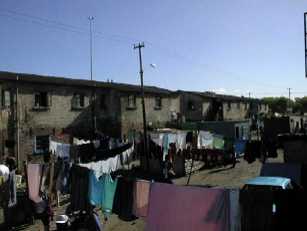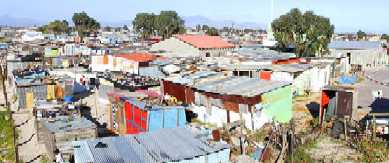Townships of the Cape Flats
Townships of the
Cape Flats
The
Cape Flats
consists of a vast number of townships where the majority of
coloured and african people live. As is consistent with the
composition of the population, most of the townships are coloured
townships and only four are home to africans.
Even with exotic
sounding names like Bishop Lavis, Steenberg,
Hanover Park, Bonteheuwel, Manenberg, Elsies River, Langa (sun),
Nyanga (Moon), Gugulethu (our pride), Khayelitsha (our new home)
and many others, living in the townships is not for the
faint-hearted. For the most parts, the townships are dreary
places, bordering on qualifying for the description of
"urban ghettoes". Houses are usually tiny and
overcrowded, and in most townships, there are blocks upon blocks
of flats which are equally tiny and serve as a breeding ground
for gang and other unsavoury activities.
The
maintenance of buildings and
roads is virtually non-existent,
though in all fairness, I need to record the fact that over the
last ten years, some attempts have been made to make the
townships look more presentable by the painting of houses and
blocks of flats, tarring roads and turning big sandy fields into
playgrounds. This has, however, mostly been in the coloured
townships and african townships continue to look quite appalling.
|

Pic. Academy of
Leadership/University of
Maryland |
An interesting
phenomenon, which clearly reflects apartheid
planning, is that african and coloured townships, in some cases
very close to each other, are separated by open strips of land, a
highway or the railway line. It is amazing how effective these
strips of "no-man's land" were, in keeping african and
coloured communities separated.
The case of
Mitchell's Plain
Mitchell's Plain is a large,
sprawling coloured township
divided into several zones. When it was initially built, about
15-20 years ago, it was billed as the area for coloureds,
ostensibly to house people in the middle income group. In no
time, parts of it deteriorated into a major slum partly due to
the fact that many people who seemingly wanted to escape the
township situation, moved to Mitchell's Plain, but could not
afford to live there. Mitchells
Plain soon became known as Mitchell's comPlain.
The case of Khayelitsha
Khayelitsha, meaning
"new home", is located
miles from the urban centre and was essentially created as a
dumping ground for africans who were not permitted to live in the
established townships of Langa, Nyanga and Gugulethu. It is a
somewhat wierd combination of formal and informal houses, with
the informal (wood and iron shacks) settlements clearly visible
from the main highway leading from the airport into town. Like
Mitchell's Plain, it is quite close to the ocean and is built on
what used to be sand-dunes.
|

Pic. Ken Liffiton |
| If you happen to be in
parts of Khayelitsha on a windy day, you will easily be forgiven for
thinking that you somehow got lost and ended up in the middle of a
sandstorm in a desert. During winter, large parts of Khayelitsha are
flooded and at least once every year the local newspapers carry
pictures of people wading knee-deep while using buckets to scoop water
out of their houses. |

Pic. Cape Argus |
|
On
a general note- in 1993, Cape Town had a housing backlog of
approximately 40 000 houses and with the numbers of people
migrating from the rural areas increasing each year, so the
backlog increases. One of the major priorities of the RDP
(Reconstruction & Development Programme) is to build houses.
Without wanting to sound unduly critical- it appears as if the
battle to provide sufficient housing has already been lost.
Having said all of the above, you
would probably expect me to be
all negative and condemnatory of the townships... yes, I am,
because I believe that everyone has the right to decent shelter.
But at the same time- the township is a lekker
place to be.
|


